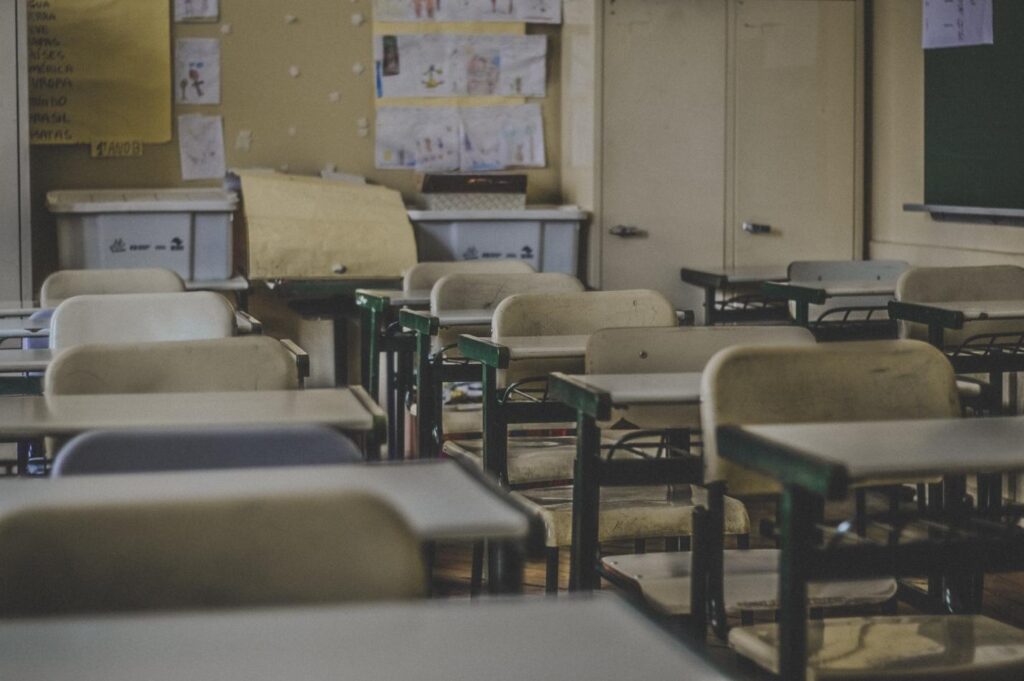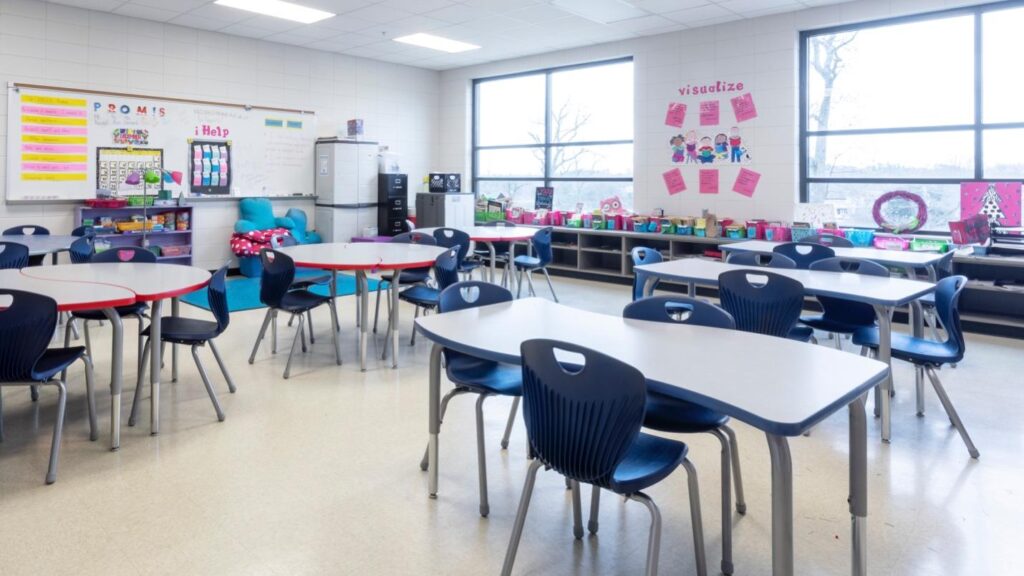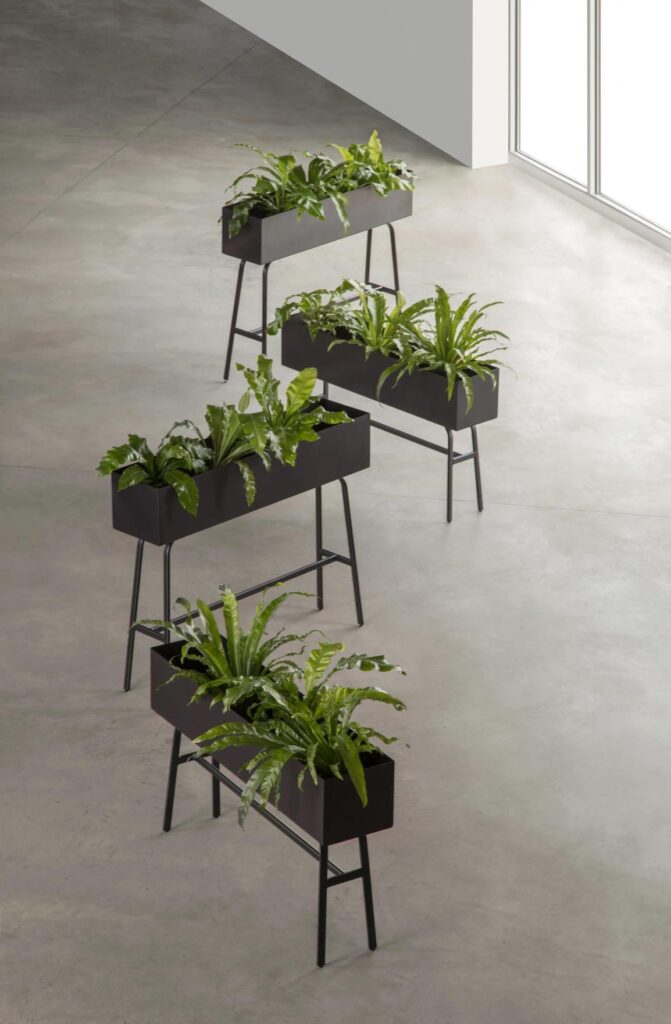Like adults, many school-aged children are affected by stress and anxiety, and often the built environment does little to relieve stressors. In fact, the built environment can actually cause additional stress and even affect learning when not designed properly.
The days of outfitting a classroom with beige walls, heavy metal desks, and a chalkboard are (hopefully) behind us, as society realizes that applying a little more thought to classroom design can pay off in a number of ways, including in enhancing students’ feelings of wellbeing.

School design is changing and becoming more thoughtful. Many K-12 schools are integrating flexibility, agility, and healthy materials, and idea of designing for occupant wellness is no longer unusual.
In fact, factors that increase feelings of wellness have also been linked to improving overall mental health, improving working memory, and sharpening cognition. It makes sense to incorporate design features that enhance feelings of wellbeing, and to support the students as human beings, and not just academic learners.
Incorporating wellness features is considerably easier to accomplish when designing a new school from the ground up, but it’s not impossible to retrofit features in an existing building with careful planning and the right team. Factors that may be integrated or adjusted to amplify feelings of wellbeing in the classroom include access to natural light and views of nature, supporting activity, and specifying healthy materials.

Windows + Light
Often, natural light is the first thing that comes to mind when envisioning wellness in the built environment. It’s been well-established that natural light and views to nature can calm emotions, reduce stress, and improve mental capabilities. But in a renovation or interior refresh it can be difficult to add windows or expand the existing windows.
Maximizing the daylight available is key: installing shades that filter light but still allow some view to the outside are an excellent way to replace old blinds and have some control over access to light and nature. If the budget allows, installing shades that operate mechanically are a nice feature to a classroom.

Bring Nature Inside
If views to the outside are minimal—or even if they’re plentiful—bringing nature inside with thoughtful interior plants is a great way to boost the wellness factor of a space. To avoid a cluttered look, select planters that are uniform, have clean lines, and are easy to maintain. Easy-to-care for plants will also reduce the mental load of maintaining indoor greenery.

Encourage Activity
It’s been established that sitting in one place for too long is not healthy and can negatively affect cognition, memory, and overall wellbeing. Often, unadaptable furniture dictates an inactive posture. Desks that are noisy or heavy to reconfigure will not often be moved. Easily mobile furniture can achieve a less sedentary—and often more engaging—learning environment. Moving the body often is also connected to feelings of wellbeing and with reducing stress.

Healthy Materials
The days of building asbestos-laden classrooms and outfitted with solid metal desks are in the past, but there are still many less-than-optimal material choices for classroom finishes and furniture). When renovating the interior finishes of a classroom, consider natural flooring materials such as linoleum and cork, rather than VCT or sheet vinyl. Natural materials are better for indoor air quality, the environment, and are often more visually pleasing and calming as well. Bonus: linoleum and cork provide some sound absorption as well. Carpet tiles with low VOCs are also a healthy choice, especially when a vacuuming regimen is implemented.
Selecting the proper materials for furniture is just as important as selecting the correct furniture solution. Materials need to be durable, visually pleasing, and appropriate for the application. Working with a qualified dealer designer on finish selection can help assure long-term success of the project.

Partnering with a dealer who has capable and qualified designers on staff will make the finish selection less daunting, and they will only show options that meet those three important factors: durability, aesthetics, and appropriate application.
Invest Intentionally
It’s becoming more obvious that student learning is deeply linked to student well-being—and that student well-being is deeply linked to the built environment. Prioritizing students and their learning means investing in an environment that supports learning, and a well-designed interior can last for generations of students.

Changing classroom interiors to increase student wellbeing doesn’t have to increase stress on the stakeholders. Understand that interior renovations or even refreshes are a long-term investment, so making good decisions regarding quality of goods and finish selection will pay off in the long run.
For more information on design solutions for wellness in educational spaces or to be connected to Interior Elements, click here
ABOUT THE AUTHOR

Anna Ruth Gatlin, PhD, is an award-winning interior designer and design researcher. Currently an Assistant Professor of Interior Design at Auburn University, she transitioned to full-time academia after a career practicing institutional, commercial, healthcare, and educational design.
